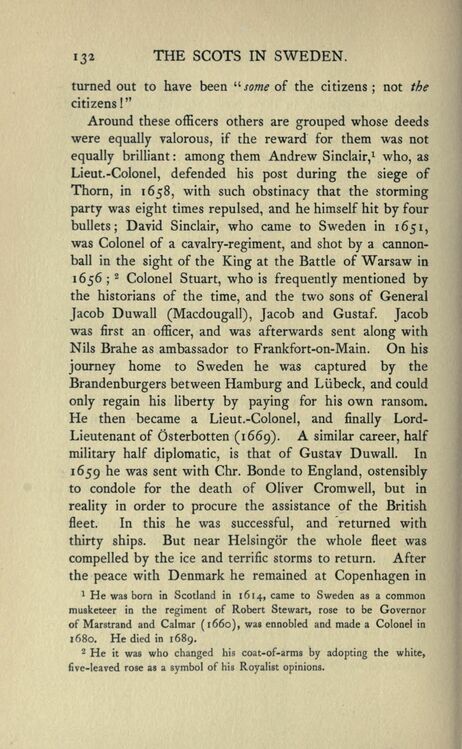
Full resolution (JPEG) - On this page / på denna sida - Sidor ...

<< prev. page << föreg. sida << >> nästa sida >> next page >>
Below is the raw OCR text
from the above scanned image.
Do you see an error? Proofread the page now!
Här nedan syns maskintolkade texten från faksimilbilden ovan.
Ser du något fel? Korrekturläs sidan nu!
This page has never been proofread. / Denna sida har aldrig korrekturlästs.
turned out to have been 44 some of the citizens ; not the
citizens!”
Around these officers others are grouped whose deeds
were equally valorous, if the reward for them was not
equally brilliant: among them Andrew Sinclair,1 who, as
Lieut.-Colonel, defended his post during the siege of
Thorn, in 1658, with such obstinacy that the storming
party was eight times repulsed, and he himself hit by four
bullets; David Sinclair, who came to Sweden in 1651,
was Colonel of a cavalry-regiment, and shot by a
cannonball in the sight of the King at the Battle of Warsaw in
1656 ; 2 Colonel Stuart, who is frequently mentioned by
the historians of the time, and the two sons of General
Jacob Du wall (Macdougall), Jacob and Gustaf. Jacob
was first an officer, and was afterwards sent along with
Nils Brahe as ambassador to Frankfort-on-Main. On his
journey home to Sweden he was captured by the
Brandenburgers between Hamburg and Liibeck, and could
only regain his liberty by paying for his own ransom.
He then became a Lieut.-Colonel, and finally
Lord-Lieutenant of Österbotten (1669). A similar career, half
military half diplomatic, is that of Gustav Duwall. In
1659 he was sent with Chr. Bonde to England, ostensibly
to condole for the death of Oliver Cromwell, but in
reality in order to procure the assistance of the British
fleet. In this he was successful, and returned with
thirty ships. But near Helsingör the whole fleet was
compelled by the ice and terrific storms to return. After
the peace with Denmark he remained at Copenhagen in
1 He was born in Scotland in 1614, came to Sweden as a common
musketeer in the regiment of Robert Stewart, rose to be Governor
of Marstrand and Calmar (1660), was ennobled and made a Colonel in
1680. He died in 1689.
2 He it was who changed his coat-of-arms by adopting the white,
five-leaved rose as a symbol of his Royalist opinions.
<< prev. page << föreg. sida << >> nästa sida >> next page >>